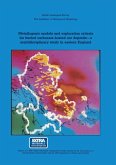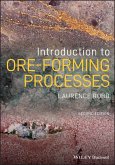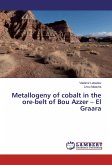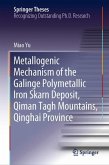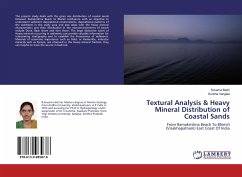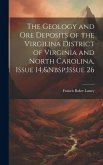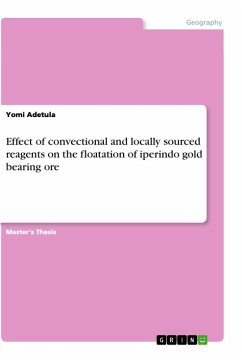Stylianos-Savvas P. Augustithis
Atlas of the Textural Patterns of Ore Minerals and Metallogenic Processes
Stylianos-Savvas P. Augustithis
Atlas of the Textural Patterns of Ore Minerals and Metallogenic Processes
- Gebundenes Buch
- Merkliste
- Auf die Merkliste
- Bewerten Bewerten
- Teilen
- Produkt teilen
- Produkterinnerung
- Produkterinnerung
Das Buch behandelt die Erzmineralien, ihr Vorkommen und ihre Geochemie. In erster Linie ist es ein Atlas der Mikrostrukturen der häufigsten und wichtigsten Phasen der Erzmineralien und enthält 926 photo-mikrographische Abbildungen.
Andere Kunden interessierten sich auch für
![Metallogenic models and exploration criteria for buried carbonate-hosted ore deposits¿a multidisciplinary study in eastern England Metallogenic models and exploration criteria for buried carbonate-hosted ore deposits¿a multidisciplinary study in eastern England]() J. A. JonesMetallogenic models and exploration criteria for buried carbonate-hosted ore deposits¿a multidisciplinary study in eastern England42,99 €
J. A. JonesMetallogenic models and exploration criteria for buried carbonate-hosted ore deposits¿a multidisciplinary study in eastern England42,99 €![Introduction to Ore-Forming Processes Introduction to Ore-Forming Processes]() Laurence RobbIntroduction to Ore-Forming Processes64,99 €
Laurence RobbIntroduction to Ore-Forming Processes64,99 €![Metallogeny of cobalt in the ore-belt of Bou Azzer ¿ El Graara Metallogeny of cobalt in the ore-belt of Bou Azzer ¿ El Graara]() Vladimir LebedevMetallogeny of cobalt in the ore-belt of Bou Azzer ¿ El Graara21,99 €
Vladimir LebedevMetallogeny of cobalt in the ore-belt of Bou Azzer ¿ El Graara21,99 €![Metallogenic Mechanism of the Galinge Polymetallic Iron Skarn Deposit, Qiman Tagh Mountains, Qinghai Province Metallogenic Mechanism of the Galinge Polymetallic Iron Skarn Deposit, Qiman Tagh Mountains, Qinghai Province]() Miao YuMetallogenic Mechanism of the Galinge Polymetallic Iron Skarn Deposit, Qiman Tagh Mountains, Qinghai Province74,99 €
Miao YuMetallogenic Mechanism of the Galinge Polymetallic Iron Skarn Deposit, Qiman Tagh Mountains, Qinghai Province74,99 €![Textural Analysis & Heavy Mineral Distribution of Coastal Sands Textural Analysis & Heavy Mineral Distribution of Coastal Sands]() Suvarna BadriTextural Analysis & Heavy Mineral Distribution of Coastal Sands26,99 €
Suvarna BadriTextural Analysis & Heavy Mineral Distribution of Coastal Sands26,99 €![The Geology and Ore Deposits of the Virgilina District of Virginia and North Carolina, Issue 14; Issue 26 The Geology and Ore Deposits of the Virgilina District of Virginia and North Carolina, Issue 14; Issue 26]() Francis Baker LaneyThe Geology and Ore Deposits of the Virgilina District of Virginia and North Carolina, Issue 14; Issue 2636,99 €
Francis Baker LaneyThe Geology and Ore Deposits of the Virgilina District of Virginia and North Carolina, Issue 14; Issue 2636,99 €![Effect of convectional and locally sourced reagents on the floatation of iperindo gold bearing ore Effect of convectional and locally sourced reagents on the floatation of iperindo gold bearing ore]() Yomi AdetulaEffect of convectional and locally sourced reagents on the floatation of iperindo gold bearing ore47,95 €
Yomi AdetulaEffect of convectional and locally sourced reagents on the floatation of iperindo gold bearing ore47,95 €-
-
-
Das Buch behandelt die Erzmineralien, ihr Vorkommen und ihre Geochemie. In erster Linie ist es ein Atlas der Mikrostrukturen der häufigsten und wichtigsten Phasen der Erzmineralien und enthält 926 photo-mikrographische Abbildungen.
Produktdetails
- Produktdetails
- Verlag: De Gruyter
- 1995.
- Seitenzahl: 676
- Erscheinungstermin: 24. April 1995
- Englisch
- Abmessung: 286mm x 215mm x 52mm
- Gewicht: 2073g
- ISBN-13: 9783110136395
- ISBN-10: 3110136392
- Artikelnr.: 05956926
- Herstellerkennzeichnung Die Herstellerinformationen sind derzeit nicht verfügbar.
- Verlag: De Gruyter
- 1995.
- Seitenzahl: 676
- Erscheinungstermin: 24. April 1995
- Englisch
- Abmessung: 286mm x 215mm x 52mm
- Gewicht: 2073g
- ISBN-13: 9783110136395
- ISBN-10: 3110136392
- Artikelnr.: 05956926
- Herstellerkennzeichnung Die Herstellerinformationen sind derzeit nicht verfügbar.
I-XII -- Part I: The Textural Patterns of Ore Minerals and Their Genetic Significance -- Chapter 1. Introductory Concepts -- Chapter 2. Consideration of the Concepts of Paragenesis, Temperature Determination and Replacement, Based on Edward's Book -- Chapter 3. Inductive Versus Deductive Approach in the Interpretation of Textures -- Chapter 4. Mantle and Lower Crust Derivatives -- Chapter 5. Replacement Patterns and Processes -- Chapter 6. Replacement Versus Ex-Solutions -- Chapter 7. Symplectites -- Chapter 8. Crystalloblastesis -- Chapter 9. Zonal Growths -- Chapter 10. Epitaxis - Epitactic Growths -- Chapter 11. Inclusions -- Chapter 12. Colloform Structures (Gel Structures) -- Chapter 13. Sphaeroidal Structures and Textures -- Chapter 14. Tectonic Effects -- Chapter 15. Weathering and Alteration of Ore Minerals -- Chapter 16. Leaching, Diffusion and Element Concentration -- Chapter 17. Penetrability (Wegsamkeit) -- Part II: Consideration of Hypotheses and Theories on Metallogeny (Study Cases) -- Chapter 18. Global Tectonics and Metallogeny -- Chapter 19. Differentiation and Metallogeny -- Chapter 20. Metallogeny Related to Ultrabasics -- Chapter 21. Granites/Pegmatites and Related Metallogeny -- Chapter 22. Granitization - Anatexis -- Chapter 23. Metallogeny Related to Granodiorites-Monzonites -- Chapter 24. Metallogeny Related to Porphyries -- Chapter 25. Skarns-Pyrometasomatic Metallogeny (and Superimposed Metallogeny) -- Chapter 26. Pneumatolytic to Hydrothermal-Hypothermal -- Chapter 27. Controversies - Various Aspects of Metallogeny -- Chapter 28. The Witwatersrand Controversy -- Chapter 29. The Broken Hill Controversy -- Chapter 30. Mount Isa Controversy -- Chapter 31. The Role of Brines in Metallogeny (The Tennessee Valley-Type of Deposits) -- Chapter 32. The Role of Brines and the Mixed Fluids Hypothesis -- Chapter 33. Lateral Segregation Processes -- Chapter 34. Volcanogenic (Volcano-Sedimentary) Deposits. -- Chapter 35. Consideration of Certain Aspects of Banded Iron Formations (BIFs) with Emphasis on Precambrian BIFs -- Chapter 36. Fluid Inclusions -- Chapter 37. Some Aspects of the Role of Fluids in Metamorphogenic Ores -- Chapter 38. Sulphur in Metallogeny -- Chapter 39. Study Cases of Isotopes and Their Significance in Metallogeny -- Chapter 40. Mass-Replacement of Rocks by Ores and Palaeo-Karst-Type Deposits -- Chapter 41. Hypogene, Supergene and Oxidation Mineralizations -- Chapter 42. Some Aspects of Manganese Mineral Formation - Transformation - Alteration - Oxidation and in General Mn-Mobilization/Remobilization -- Chapter 43. The Significance of Leaching and Diffusion Processes in Ore Formation -- Chapter 44. Redistribution - Mobilization - Remobilization -- Chapter 45. Zonal Distribution of Elements and Minerals -- Chapter 46. Source and Recipient Geoenvironments of Mineralization -- Part III: On the Distribution of Elements and Ore Parageneses. The Empirical Laws of Element Segregation-Concentration in Ores -- Chapter 47. The Empirical "Laws" of Element Segregation/Crystallochemistry/Isotope Chemistry Versus Genesis of Ores - State of the Art -- Chapter 48. Segregation of Elements in Accordance with Their Interrelationships to Form Mineral Association-Parageneses -- Chapter 49. Common (Joint) Segregation of Elements -- Chapter 50. Hydrothermal and Pegmatitic Element Segregation to Form U-Parageneses -- Chapter 51. Superimposed Paragenesis (Element Segregation/Distribution Processes) -- Chapter 52. Ti, V, Cr - Their Interrelationships and Antipathies -- Chapter 53. The Te, Se, Bi, Au, Ag Element Segregation/Distribution (in Paragenetic Associations) -- Chapter 54. Realgar, Orpiment - Cinnabar - Metacinnabar Parageneses -- Chapter 55. A Special Case of Non-Ferrous Metal Mineralization in Evaporites -- Chapter 56. The Segregation (Distribution) of Sn, Mo and W to Form Concentrations or Ore Deposits -- Chapter 57. Special Cases of Element Segregation/Distribution -- Chapter 58. Element Seg
I-XII -- Part I: The Textural Patterns of Ore Minerals and Their Genetic Significance -- Chapter 1. Introductory Concepts -- Chapter 2. Consideration of the Concepts of Paragenesis, Temperature Determination and Replacement, Based on Edward's Book -- Chapter 3. Inductive Versus Deductive Approach in the Interpretation of Textures -- Chapter 4. Mantle and Lower Crust Derivatives -- Chapter 5. Replacement Patterns and Processes -- Chapter 6. Replacement Versus Ex-Solutions -- Chapter 7. Symplectites -- Chapter 8. Crystalloblastesis -- Chapter 9. Zonal Growths -- Chapter 10. Epitaxis - Epitactic Growths -- Chapter 11. Inclusions -- Chapter 12. Colloform Structures (Gel Structures) -- Chapter 13. Sphaeroidal Structures and Textures -- Chapter 14. Tectonic Effects -- Chapter 15. Weathering and Alteration of Ore Minerals -- Chapter 16. Leaching, Diffusion and Element Concentration -- Chapter 17. Penetrability (Wegsamkeit) -- Part II: Consideration of Hypotheses and Theories on Metallogeny (Study Cases) -- Chapter 18. Global Tectonics and Metallogeny -- Chapter 19. Differentiation and Metallogeny -- Chapter 20. Metallogeny Related to Ultrabasics -- Chapter 21. Granites/Pegmatites and Related Metallogeny -- Chapter 22. Granitization - Anatexis -- Chapter 23. Metallogeny Related to Granodiorites-Monzonites -- Chapter 24. Metallogeny Related to Porphyries -- Chapter 25. Skarns-Pyrometasomatic Metallogeny (and Superimposed Metallogeny) -- Chapter 26. Pneumatolytic to Hydrothermal-Hypothermal -- Chapter 27. Controversies - Various Aspects of Metallogeny -- Chapter 28. The Witwatersrand Controversy -- Chapter 29. The Broken Hill Controversy -- Chapter 30. Mount Isa Controversy -- Chapter 31. The Role of Brines in Metallogeny (The Tennessee Valley-Type of Deposits) -- Chapter 32. The Role of Brines and the Mixed Fluids Hypothesis -- Chapter 33. Lateral Segregation Processes -- Chapter 34. Volcanogenic (Volcano-Sedimentary) Deposits. -- Chapter 35. Consideration of Certain Aspects of Banded Iron Formations (BIFs) with Emphasis on Precambrian BIFs -- Chapter 36. Fluid Inclusions -- Chapter 37. Some Aspects of the Role of Fluids in Metamorphogenic Ores -- Chapter 38. Sulphur in Metallogeny -- Chapter 39. Study Cases of Isotopes and Their Significance in Metallogeny -- Chapter 40. Mass-Replacement of Rocks by Ores and Palaeo-Karst-Type Deposits -- Chapter 41. Hypogene, Supergene and Oxidation Mineralizations -- Chapter 42. Some Aspects of Manganese Mineral Formation - Transformation - Alteration - Oxidation and in General Mn-Mobilization/Remobilization -- Chapter 43. The Significance of Leaching and Diffusion Processes in Ore Formation -- Chapter 44. Redistribution - Mobilization - Remobilization -- Chapter 45. Zonal Distribution of Elements and Minerals -- Chapter 46. Source and Recipient Geoenvironments of Mineralization -- Part III: On the Distribution of Elements and Ore Parageneses. The Empirical Laws of Element Segregation-Concentration in Ores -- Chapter 47. The Empirical "Laws" of Element Segregation/Crystallochemistry/Isotope Chemistry Versus Genesis of Ores - State of the Art -- Chapter 48. Segregation of Elements in Accordance with Their Interrelationships to Form Mineral Association-Parageneses -- Chapter 49. Common (Joint) Segregation of Elements -- Chapter 50. Hydrothermal and Pegmatitic Element Segregation to Form U-Parageneses -- Chapter 51. Superimposed Paragenesis (Element Segregation/Distribution Processes) -- Chapter 52. Ti, V, Cr - Their Interrelationships and Antipathies -- Chapter 53. The Te, Se, Bi, Au, Ag Element Segregation/Distribution (in Paragenetic Associations) -- Chapter 54. Realgar, Orpiment - Cinnabar - Metacinnabar Parageneses -- Chapter 55. A Special Case of Non-Ferrous Metal Mineralization in Evaporites -- Chapter 56. The Segregation (Distribution) of Sn, Mo and W to Form Concentrations or Ore Deposits -- Chapter 57. Special Cases of Element Segregation/Distribution -- Chapter 58. Element Seg


